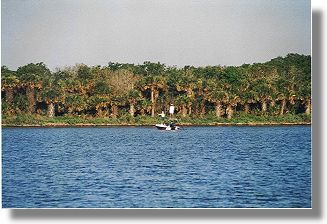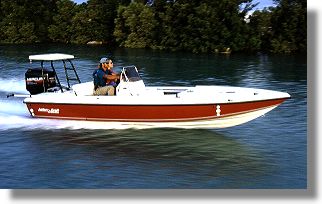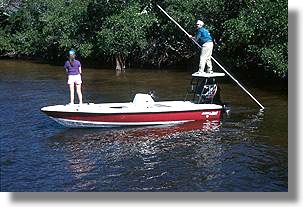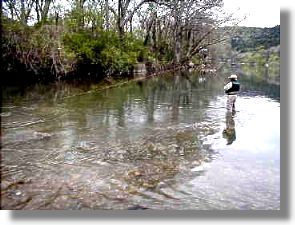Rain fell in a steady downpour. The windshield
wipers pushed the water off with each side-to-side swipe.
Annie and Rob were asleep in their seats. Annie's head was
tilted into the headrest. Her mouth was slightly open, taking
in shallow breaths. Dark sunglasses drooped off her nose.
Rob was asleep with his paws stretched out on the back seat,
face settled onto his legs. His left ear half draped over one
paw.
The local radio station announced road closings and bad
weather ahead. A low-pressure system was moving through the
Shenandoah Valley that was bringing thunder, lightning, rain,
fog, hail, and strong winds. I was trying to beat the storm,
and so far succeeding. Our wheels made a low whistling noise
on the wet pavement followed by regular slapping from the patches
in the road surface. The trailer I was towing was bouncing from
all the irregularities in the road. It reminded me off the worst
days in the lagoon. A guide's nightmare. When conditions get
really bad a guide has to work harder. The intensity can be
overwhelming because you have to be in the 'zone.' Your
concentration level is at its highest. Your first concern
is for the safety of your clients.
I listened for unusual sounds, watched the road intently, and
concentrated on the traffic and rain that was coming more heavily.
A few hundred miles more and we would be away from the storm.
We just crossed the Mason-Dixon Line on our way to Annie's
dad's house. He wasn't well and she was going to spend
the summer with him. The trailer, loaded with some
creature comforts, slowed us down. But, we weren't in
any rush and the driving was horrible. The rain came
down harder. I don't mind the rain so much, but do hate fog.
Mustang Sally was playing softly on the radio. It was hard
to hear over the rain, so I reached over and turned it off.
All was quiet inside, except for the noise outside. My mind
wandered, but still very alert to the driving. I was getting
some needed time for myself. I thought about fly-fishing and
some of the great fishing you can have in rainy weather. I
wondered about fishing in freshwater, which I hadn't done for
some time.

Naturally, I thought of you. I couldn't help it. Just two
days ago, I tried beating the storm in the lagoon. Rain pelted
my party. There is no place to hide from bad
weather in a flats boat. We huddled together on the bench
seat. Scrunched down like rabbits in a borough, we tried
to stay dry. It didn't work, saltwater stings in the wind.
The waves built to 4-feet at short intervals, making running
a challenge. We had to be on plane. It was a wet, rough
ride. For most of six miles we endured white caps and
over-spray. It can really get uncomfortable in a flats boat.
But we needed to maintain stability and control. I needed
to get away from the storm.
So, here I am throwing you a lifeline. The rain
brought this revelation to me. Anglers who hire guides
don't consider weather, wind, rain, fog, or waves. They
are almost never prepared. All you need is the basics:
nylon rain jacket and pants, hat, and sunglasses. Have
them even if they aren't needed. They don't take up much space,
but come in handy. After all, if you fish in Florida, the
Sunshine State, everything should be perfect. Always trust
Murphy's Law: anything that can go wrong, will go wrong.
The reality is, you will experience wet conditions, rough
going in a flats boat at some time when you least expect it.
Given the situations that you might encounter, rare as they are,
be prepared. It doesn't even have to rain for the flats to
get nasty. Shallow water can turn rough in a matter of
minutes. If you are 10 miles from the ramp, it's a long
way to take a beating. I know. Ok, you came here for the
fly-fishing. You are on vacation or on a business trip and
here is this candy-jar called water drawing you to take a handful.
I'm not trying to be a red herring. Let me help set your
expectations for your next trip. Here's the scoop on Flats
Boats.
 Flats boats are low profile, mustangs, designed to skim over
the grasses in very shallow water at high speed. To do this they
must be on plane, running 25 mph or faster. They have very little
freeboard. Freeboard is a term used in measuring the distance
between the gunnel and the water. In a bow-rider type of boat
the freeboard could be 18-inches or more. In a flats boat the
freeboard will be 12-inches or less. You'll also notice that
a flats boat has very few places to sit. That's because a
flats boat has more deck area for fishing. After all it's a
fishing boat. So creature comforts are absent, although some
have better seating than others with cushions on the console
seat and padded bench seats.
Flats boats are low profile, mustangs, designed to skim over
the grasses in very shallow water at high speed. To do this they
must be on plane, running 25 mph or faster. They have very little
freeboard. Freeboard is a term used in measuring the distance
between the gunnel and the water. In a bow-rider type of boat
the freeboard could be 18-inches or more. In a flats boat the
freeboard will be 12-inches or less. You'll also notice that
a flats boat has very few places to sit. That's because a
flats boat has more deck area for fishing. After all it's a
fishing boat. So creature comforts are absent, although some
have better seating than others with cushions on the console
seat and padded bench seats.
Flats boats are similar to bass boats. They have big engines
so you can get to a fishing spot quickly. Sometimes you have
to cover a lot of area to find fish, 30 miles is not uncommon.
The reason these boats have poling platforms is because when
they do shut down, the water is usually too shallow to motor
back up on plane. You'll see the guides stand on an elevated
platform to pole through the shallow water (12-inches deep or
less). Guides pole their boats for hours. Think about it
next time you are on the flats. That's a lot of aerobic
exercise to put you on fish. Pushing a 1500-pound boat
around is exhausting. If you've ever wondered why guides
wear long sleeves and long pants it is because they are exposed
to the sun's direct rays for hours. Be sure you are protected too.

The poling platform provides the guide with a high vantage
point to spot fish. Because the flats are so shallow, he can
see a hundred yards ahead and spot fish you can't see. That's
why they point in a direction where you see no fish. Trust them.
The fish are there. A lot of fly-fishing guides prefer their
anglers to wait and cast to fish they sight. The reason is,
the motion of the cast transmits to the boat through waves on
the water. The slightest ripple will scare fish. That's another
reason they pole in the flats. It is a stealth factor, to sneak
up on the fish.
Some flats boats have 'jack plates.' Jack plates help elevate
the engine so that the prop is higher allowing boats to power out.
When there is no wind, or very little, and calm water, the flats
boat glides across giving a smooth, fast ride. If conditions
deteriorate you will find the ride bumpy and uncomfortable. This
is because the boat has to stay on plane, riding the tops of the
waves. Some flats boats ride the waves better than others.
Boats with a 'v' hull, will take the waves with less bounce.
Flat-bottomed boats will be very rough, because they will just
slap each wave, and can't cut through like the 'v-bottom.'

So there it is. Everything you always wanted to know about
flats boats but were afraid to ask. Be realistic about your
next fly-fishing trip. Pay attention to the conditions, and
take the basic steps to be prepared. I guarantee you'll have
a much more pleasurable trip. When your guide says he is sorry
for the ride just remember he feels it too, and he feels guilty
about the conditions. The guide has no control over Mother
Nature. Make the best of your time on the water. Just be
street smart about it. Oops, here's my exit. We did beat
the storm.
Until next time ~ Doug
About Doug:
Capt. Doug Sinclair has relocated from New Smyrna Beach, Florida to
Grantsboro, NC. He specializes in fly-fishing and light tackle charters.
Doug charters the Coastal Carolina area of New Bern or Oriental.
Catch him on the web at
www.flyfishacademy.net or call him at (252) 745-3500.
Doug is also a Sponsor here on FAOL.
|



 Flats boats are low profile, mustangs, designed to skim over
the grasses in very shallow water at high speed. To do this they
must be on plane, running 25 mph or faster. They have very little
freeboard. Freeboard is a term used in measuring the distance
between the gunnel and the water. In a bow-rider type of boat
the freeboard could be 18-inches or more. In a flats boat the
freeboard will be 12-inches or less. You'll also notice that
a flats boat has very few places to sit. That's because a
flats boat has more deck area for fishing. After all it's a
fishing boat. So creature comforts are absent, although some
have better seating than others with cushions on the console
seat and padded bench seats.
Flats boats are low profile, mustangs, designed to skim over
the grasses in very shallow water at high speed. To do this they
must be on plane, running 25 mph or faster. They have very little
freeboard. Freeboard is a term used in measuring the distance
between the gunnel and the water. In a bow-rider type of boat
the freeboard could be 18-inches or more. In a flats boat the
freeboard will be 12-inches or less. You'll also notice that
a flats boat has very few places to sit. That's because a
flats boat has more deck area for fishing. After all it's a
fishing boat. So creature comforts are absent, although some
have better seating than others with cushions on the console
seat and padded bench seats.
